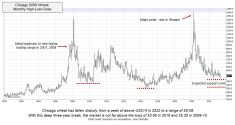Ontario received average to below average precipitation in May and temperatures were cooler than normal. Ontario farmers have finished planting and emergence of the row crop is 10-14 days behind normal.
The forecast calls for below normal precipitation and above average temperatures for June. Farmer selling has dried up, given current crop conditions. There are concerns about yield drag for corn and soybeans.
Yield uncertainty comes on the heels of lower ending stocks projections for row crops. The domestic corn and soybean markets are trading at a premium to world values. The winter wheat crop has experienced optimal conditions through the flag leaf stage. Above–average yields are expected. The Ontario wheat market has solid demand at current levels as domestic millers step forward for new crop supplies.
Read Also

Ontario farmland values flat in first half of 2025, says FCC
Canadian farmland values rose by an average of six per cent in the first half of 2025 according to a new report from Farm Credit Canada.
Quick look
Soybeans: Soybean meal will be the main driver of crush margins in 2023-24, favouring soybean crushing in Ontario instead of canola.
Corn: World values will trend lower over the next two months.
Wheat: Ontario wheat will face stiff competition in the first half of the crop year.
At the time of writing this article, the weather forecast for much of the U.S. Midwest called for below normal precipitation and above normal temperatures. The corn and soybean futures are incorporating a risk premium due to the uncertainty in production.
U.S. offers out of the Gulf for corn and soybeans are premium to Brazilian origin. U.S. export demand has subsided in the short term. China continues to cancel U.S. corn sales. Brazil’s Safrinha corn harvest is in the early stages. Brazilian soybeans continue to dominate the world market, while Chinese demand has softened.
Russia agreed to extend the Black Sea Grain Initiative but appears to be stalling on vessel inspections. Ukraine grain exports have taken a back seat while Russian exports exceed expectations. Russia complains that exports are suffering but official data shows the reverse. Russian offers continue to set the floor for the wheat complex although U.S. soft red winter and French soft wheat are priced at competitive levels.
The Canadian dollar remains rangebound with support at 73 cents US and resistance at 75.5 cents. When a currency trades in a range for a long period of time and then breaks out, there is usually a significant move. The Bank of Canada and the U.S. Federal Reserve will continue to increase their policy rate to bring down inflation.
Job gains and wage growth have kept the labour market tight and underpinned core inflation readings. While analysts have been quick to forecast economic contraction for the U.S. and Canada, it will likely take another year before the labour market loosens. It takes about 18 months for interest rate hikes to fully work through the economy.
Soybeans
As of May 28, Brazilian soybeans were offered at US$468/tonne f.o.b. Paranagua, down $23/tonne from 14 days earlier. U.S. soybeans were quoted at $520/tonne f.o.b. the Gulf, down $25/tonne from two weeks prior. Weakness in the world market has weighed on Ontario soybean prices.
Ontario on-farm soybean stocks are expected to drop to 5,000 tonnes at the end of the 2022-23 crop year. This is considered bin bottom levels. In the previous issue, we mentioned that the soybean market would maintain a premium over world values in an effort to curb export movement. Ontario soybeans were quoted at US$525/tonne f.o.b. St. Lawrence port for nearby shipment, which was a small premium over U.S. offers.
The Ontario market also needs to trade high enough to encourage about 150,000 tonnes of imports from just south of the border. Domestic crush bids in Ontario are equivalent to elevator bids south of the border. Ontario basis levels are expected to strengthen in summer as the domestic market pulls stocks from the U.S.
New crop elevator bids for October delivery are $2.50/bu. discount to the June position. The soybean market is functioning to encourage demand for new crop positions. In the previous issue, we discussed the record U.S. soybean production coming on the heels of historical large Brazilian output. Ontario output is estimated at four million tonnes, similar to last year and the five-year average.
Argentina is the world’s largest soymeal exporter. The crop size will likely finish around 25 million tonnes, down from last year’s output of 44 million tonnes. Last year, the soybean crush margin was heavily influenced by the oil component. This will change in 2023-24 as meal will be the main driver of crush margins. This favours soybean crushing in Ontario instead of canola.
Another factor to consider is that Chinese soybean demand is lower than anticipated in the short term as its economy struggles to recover after COVID. The USDA is forecasting Chinese soybean imports at 100 million tonnes for the 2023-24 crop year, up two million tonnes from 2022-23. The Chinese import program will be back-end heavy, which favours Brazilian origin instead of U.S. soybeans in the harvest period.
What to do: We have advised farmers to be 100 per cent sold on their 2022 output. Producers should be 15-20 per cent sold on expected 2023 production. Domestic basis levels may strengthen in the short term but the overall soybean complex is bearish.
Corn
At the time of writing this article, Brazilian corn was quoted at US$240/tonne f.o.b. Paranagua, unchanged from 14 days earlier. U.S. corn was valued at $264/tonne f.o.b. the Gulf, down $5/tonne from two weeks prior. French corn was valued at $250/tonne f.o.b. La Pallice while Ontario corn was quoted at $260/tonne f.o.b. St Lawrence. French farmers held back on sales in the first half of the crop year and they are now liquidating old crop supplies.
We continue to forecast an Ontario corn carryout of 1.5 million tonnes, down from 2021-22 ending stocks of two million tonnes and down from the five-year average ending stocks of 1.8 million tonnes. For old crop movement, Ontario prices are premium to French and Brazilian origin, which has slowed offshore trade to Northern Europe.
The domestic market is rationing demand by trading at a premium to world values. It’s important to note that Ontario feed usage makes a seasonal high in May and then decreases each month until August or September. Once feedlots start to fill in October, monthly feed usage trends higher.
World values will trend lower over the next two months. The main Brazilian Safrinha harvest will move into high gear in June. Total Brazilian corn production is expected to reach a record of 130 million tonnes, up 14 million tonnes from last year. Domestic Brazilian prices are around $4.25/bu.
The USDA estimated 2023 production at 388 million tonnes, up from 40 million tonnes from last year. This was using an average yield of 181.5 bu./ac. At the time of writing this article, the Midwest weather forecast for the next 14 days had limited precipitation and above normal temperatures. The corn futures dipped down to $5/bu. May 22 but had since rallied 35 cents/bu. The corn market is incorporating a risk premium due to the uncertainty in production. If yields dip to 163/bu., then production will be similar to last year at 348 million tonnes. This would be extremely bullish for new crop prices.
We continue to project an Ontario corn crop of 9.5 million tonnes, unchanged from last year but up from the five-year average of nine million tonnes. The weather forecast looks more favourable for Ontario and we don’t expect yield drag during the summer.
What to do: We’ve advised Ontario farmers to be 100 per cent sold on their 2022 production and 20 per cent sold on new crop. The market will be rather soft during the summer due to the larger Brazilian harvest. There is a higher probability that the U.S. crop will be lower than 388 million tonnes. We’re expecting a seasonal rally during the fall period. The French crop is also off to a decent start but we believe there will be better export potential for the Ontario crop in the 2023-24 crop year.
Wheat
The Ontario winter wheat crop is in the flag leaf stage and above average yields are expected. We’re projecting a winter wheat crop of 2.7 million tonnes, up from the five-year average of 2.1 million tonnes. Approximately one million tonnes will be used domestically. Exports are also projected to reach one million tonnes and 700,000 tonnes will be used in the Ontario domestic feed market.
Ontario old crop soft red winter wheat prices are hovering around $7.40/bu., while new crop elevator bids are averaging $7/bu. Old crop corn values are also at $7/bu. New crop feed wheat is priced into the Ontario domestic feed market, which will limit the downside for both old and new crop soft red winter wheat values.
Talk in the trade is that domestic millers are also stepping forward for new crop requirements. Basis levels for Ontario wheat are seasonally wide during June and July. In a normal year, the wheat futures market makes a seasonal low in late July and early August. Avoid selling wheat in the summer.
On the world market, Russian wheat is offered at US$240/tonne f.o.b. Black Sea; French milling wheat is quoted at $246/tonne f.o.b. Rouen while U.S. soft red winter is priced at $250/tonne f.o.b. the Gulf. U.S. hard red winter wheat is valued at $360/tonne f.o.b. the Gulf.
Outside the U.S. hard red winter wheat region, there are no problems with the Northern Hemisphere wheat crop. The U.S. soft red winter wheat crop is projected to reach 12.5 million tonnes, up from the 2022 output of 10.2 million tonnes.
Usually, U.S. millers buy a large volume of Ontario wheat. For the 2023-24 campaign, Ontario wheat will have to move to alternative destinations. Keep in mind there will be strong competition from U.S. and Russian origin into Mexico. The Ontario market has stiff competition in the first half of the crop year.
Egypt is the world’s largest wheat importer and Russian origin has been saturating this market. Recently, Egypt has run low on currency reserves. Reuters reports that there are eight to 11 cargoes of wheat that are not paid for. Egypt is the floor price on the world market and failure to pay for wheat has set a negative tone in the short term.
The wheat market is entering the Northern Hemisphere harvest period. The U.S. hard red winter wheat harvest will move into high gear during June. U.S. softer red, German and French soft wheat harvests begin in June and move into full swing in July. The Russian winter wheat harvest period also occurs during June, July and extends into August. This is followed by the Canadian, U.S. and Russian spring wheat harvests in August and September. There is no shortage of wheat on the world market during the next four months.
What to do: We’ve advised producers to be 100 per cent sold on old crop. We haven’t recommended sales for new crop. Wheat is one crop farmers need to store. Our first sales recommendation will occur in October or early November.














